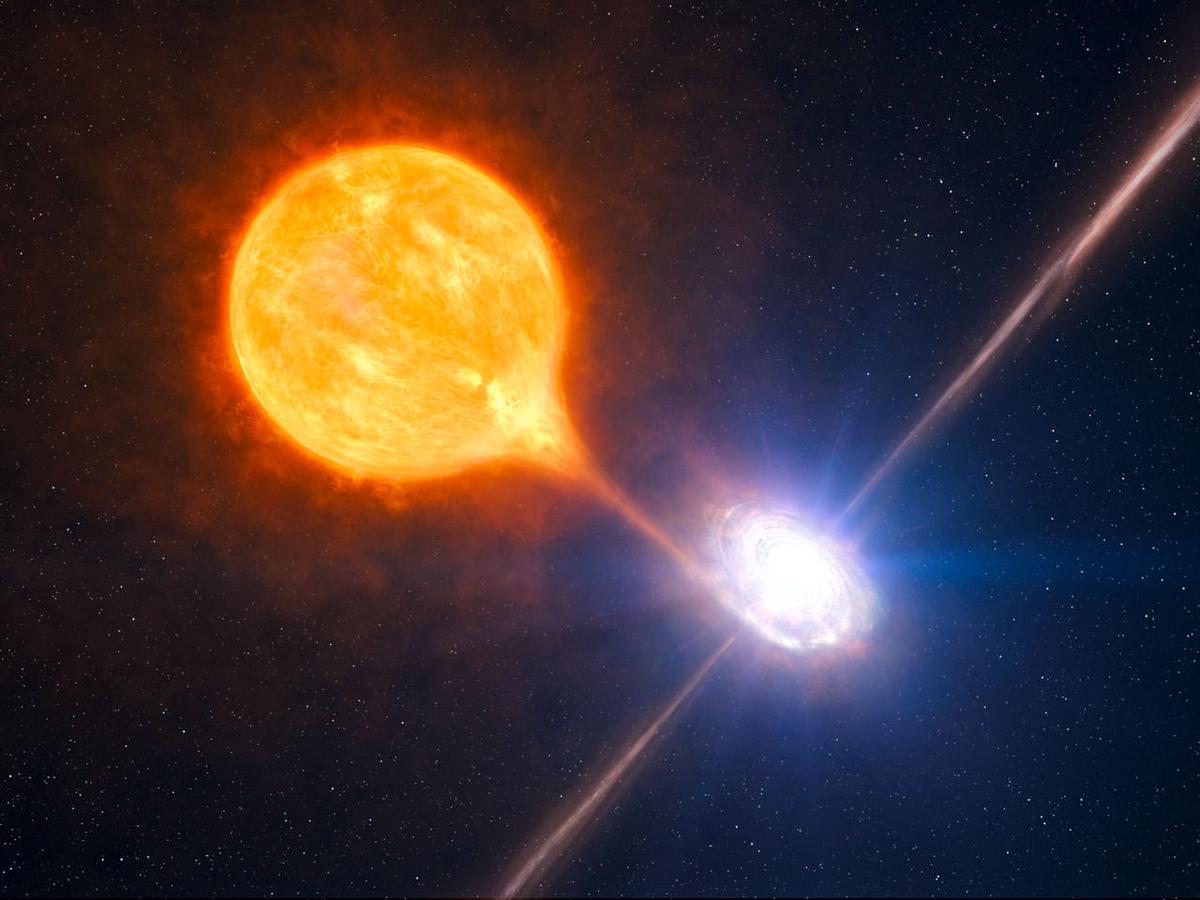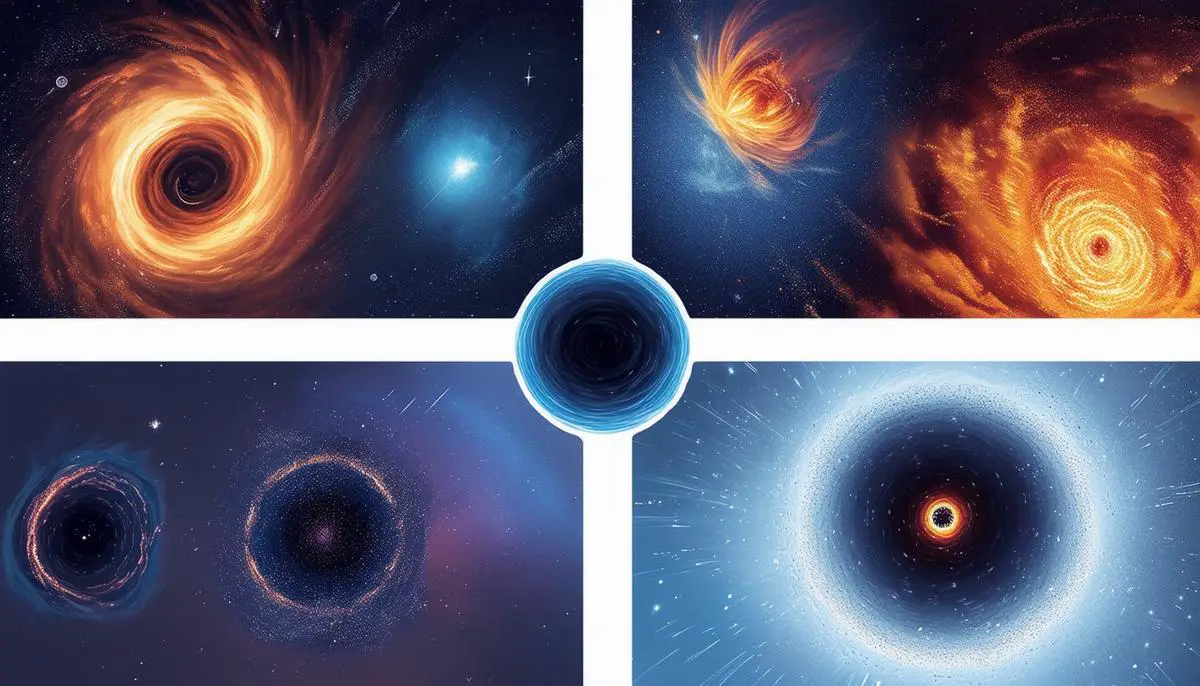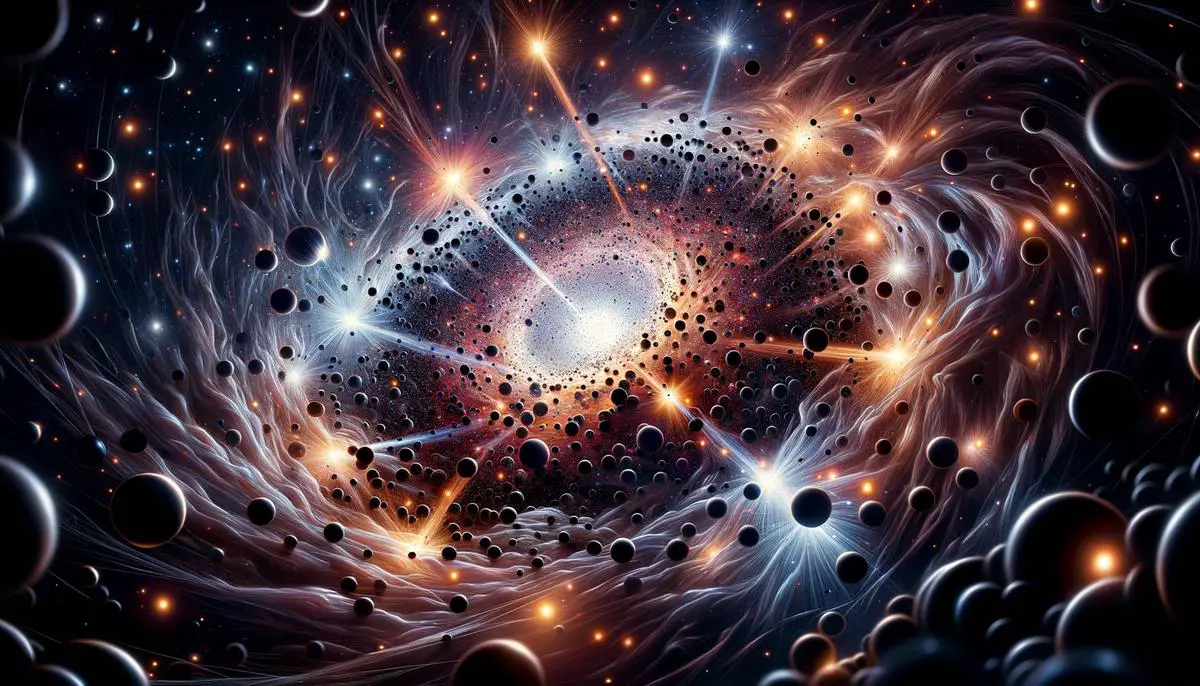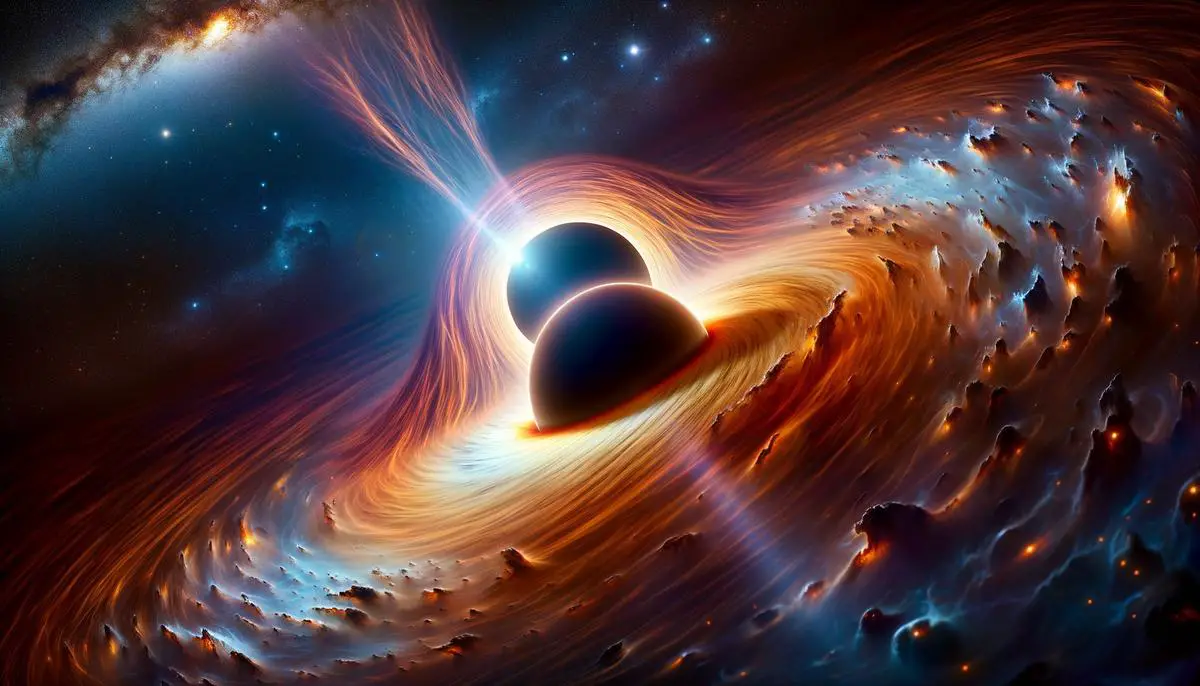In the vast expanse of our universe, black holes continue to captivate scientists and enthusiasts alike. Recent discoveries, such as Gaia BH3, shed light on the intriguing processes behind black hole formation and growth. By examining different types of black holes and their feeding mechanisms, we gain a deeper understanding of these cosmic phenomena and their impact on the galaxies they inhabit.
Discovery of Gaia BH3
Astronomers have pinpointed Gaia BH3, our galaxy's most massive known stellar black hole. This giant was discovered through the wobble it caused in its companion star, as viewed by the European Space Agency's Gaia mission and confirmed by ESO's Very Large Telescope (VLT) in Chile. Gaia BH3 weighs an impressive 33 solar masses.1
The companion star of Gaia BH3 provides clues about the black hole's formation. Its metal-poor composition suggests the collapsed star that formed Gaia BH3 was similarly metal-poor. Stars with fewer heavy elements lose less mass and can form more massive black holes.
While massive black holes have been spotted outside our galaxy, confirming their existence within the Milky Way supports theories about metal-poor stars leading to heavier black holes. The research, led by Pasquale Panuzzo and published in Astronomy & Astrophysics, shows that Gaia BH3 is part of a larger pattern of black hole creation.
The discovery also demonstrates the value of collaboration between ground-based observatories and space missions like Gaia. Future instruments, such as GRAVITY on ESO's VLT Interferometer, may offer further insights into Gaia BH3's properties and environment.
Gaia BH3's record-setting mass and the metal-poor nature of its companion star place it in a unique category. Each new discovery reshapes our understanding of the universe's complexities, and more revelations are likely on the horizon as curious minds continue to explore the cosmos.

Types of Black Holes
Black holes come in three main types:
- Stellar-mass: Like Gaia BH3, these form from the deaths of massive stars. When a star exhausts its nuclear fuel, it collapses under its own gravity. Stars beyond eight solar masses can collapse into black holes, often accompanied by a supernova explosion. These black holes typically range from a few to a few tens of solar masses, with Gaia BH3's 33 solar masses pushing the upper limit.
- Supermassive: Supermassive black holes (SMBHs) reside at the centers of most large galaxies, including the Milky Way's Sagittarius A*. SMBHs have masses ranging from millions to billions of solar masses. Their formation is still a mystery, but theories suggest they grew over time from smaller "seed" black holes, possibly formed soon after the Big Bang.
- Intermediate-mass: Intermediate-mass black holes (IMBHs) bridge the gap between stellar-mass and supermassive black holes, with masses ranging from a few hundred to a few thousand solar masses. These elusive objects are believed to form through mergers of smaller black holes or collisions of massive stars in dense star clusters. Astronomers are actively searching for evidence of IMBHs in globular clusters and other cosmic environments.
Understanding the different types of black holes deepens our knowledge of the universe's structure and evolution. Each type provides insights into various cosmic processes, from stellar death to galaxy formation. As discoveries like Gaia BH3 continue to surprise us, the ongoing search for black holes across the mass spectrum promises to reveal even more about these captivating cosmic phenomena.
Feeding Mechanisms of Supermassive Black Holes
Supermassive black holes (SMBHs) exhibit diverse feeding behaviors, ranging from steady streams of dust and gas to dramatic star-consuming episodes.
The Andromeda galaxy provides an intriguing example of a quietly feeding SMBH. Scientists discovered long dust streams spiraling into the galaxy's core, steadily nourishing the central black hole.2 Simulations suggest that the black hole forms a small, hot gas disk near its event horizon, replenished by multiple streams of gas and dust within specific size and speed parameters. This orderly feeding process contrasts with the bright fluctuations caused by sporadic, chaotic consumption.
On the other hand, some SMBHs engage in tumultuous feeding frenzies, devouring matter so rapidly that they outshine all the stars in their host galaxies. These episodes are often accompanied by quasars—powerful, bright emissions driven by the intense gravitational energy release.
The various feeding mechanisms offer insights into the nature of SMBHs and their impact on their galactic surroundings. Quiet feeders like Andromeda's SMBH demonstrate the subtle ways in which black holes can grow, while the dramatic outbursts of quasars showcase their immense power.
As our observational capabilities advance, we continue to uncover new details about SMBH feeding behaviors. Each discovery contributes to our understanding of these cosmic giants and their role in shaping the galaxies they inhabit, from formation to ongoing evolution. The study of supermassive black holes and their diverse appetites promises to keep astronomers engaged for years to come, as they work to unravel the mysteries of these captivating cosmic entities.

Intermediate-Mass Black Holes in Globular Clusters
Globular clusters are densely packed, spherical collections of stars that orbit the cores of galaxies. In this crowded cosmic environment, the dance of stars can lead to runaway collisions, potentially birthing intermediate-mass black holes (IMBHs) ranging from a few hundred to a few thousand solar masses.
Catching an IMBH within a globular cluster is more complex than simply peering through a telescope. One effective method involves observing high-velocity stars ejected from clusters. These high-velocity runaways act as clues, signaling the past presence of an IMBH. One example is the star J0731+3717, which analysts found speeding away from the core of Messier 15 (M15), suggesting it was ejected by a lurking IMBH likely containing about 100 solar masses.
In addition to observing ejected stars, researchers utilize advanced simulations to zero in on potential IMBHs. By digitally recreating the conditions within globular clusters, scientists can witness simulated star collisions and black hole mergers that could lead to the formation of an IMBH. A team at the University of Tokyo crafted detailed simulations demonstrating how massive star collisions in densely packed environments could indeed result in the birth of IMBHs.1
Another compelling line of evidence comes from the conditions necessary for star clusters to form and sustain IMBHs. As stars fuse in these clusters, the collisions and mergers within the densely packed environment provide fertile ground for runaway growth, eventually producing an IMBH. Researchers anticipate that upcoming supercomputer simulations may even enable modeling entire galaxies by resolving individual stars, thus allowing deeper insights into the birth and evolution of IMBHs in various cosmic settings.
While direct detections remain rare, indirect methods such as observing high-velocity stars and conducting sophisticated simulations offer promising avenues. Each new discovery serves as a vital jigsaw piece, bridging our understanding of the complex evolutionary pathways that connect stellar-mass black holes with their supermassive counterparts.
As technology advances, especially with projects like the Gaia mission and its follow-ups, we can expect more frequent breakthroughs. Future explorations, including gravitational wave observatories and enhanced space telescopes, promise to unravel further mysteries surrounding IMBHs, making them not just subjects of speculation but well-documented residents in our universe's cosmological index.

Supermassive Black Hole Mergers in the Early Universe
Recent findings from the James Webb Space Telescope (JWST) have revolutionized our understanding of supermassive black holes (SMBHs). In a groundbreaking discovery, JWST identified the most distant merger of SMBHs ever detected, occurring just 740 million years after the Big Bang.
This discovery fundamentally reshapes our understanding of how SMBHs grew to their massive sizes so rapidly. The merging behemoths reside in the hearts of galaxies that were in the throes of formation, suggesting that SMBH mergers were a critical mechanism driving the rapid build-up of mass in the early universe.
The JWST's infrared vision was crucial in revealing these early cosmic collisions. It zoomed in on ZS7, a galactic system located about 12 billion light-years away, identifying dense gas with swift movements near the black holes and detecting hot, highly ionized gas. This finding suggests that the black holes were in active accretion phases—voraciously feeding and growing. One of these behemoths alone weighed around 50 million solar masses, with its companion likely similar in size.2
The implications of these findings are broad. Massive SMBHs at such early stages imply that these entities significantly influenced the evolution of their host galaxies from the very beginning. Their intense gravitational pull likely orchestrated the cosmic dance of gas and stars, shaping galactic formation and evolution in critical ways.
JWST's discovery showcases the unexpected frequency of such mergers, necessitating a recalibration of our models concerning the rates and impact of SMBH mergers in the nascent universe. Future observations by JWST and complementary missions will unlock even more secrets, probing the intertwined growth of massive black holes and their galaxies during the first billion years post-Big Bang.
As the frontier of astronomical discovery pushes ever forward, we stand on the brink of further revelations, each one peeling back another layer of the universe's grand narrative.

The discovery of Gaia BH3 and other black holes offers valuable insights into the complex nature of our universe. Each new finding enhances our comprehension of black hole formation and evolution, highlighting the intricate dance of cosmic forces at play. As we continue to uncover these celestial mysteries, we move closer to a more complete understanding of the universe's grand narrative.
The exploration of black holes is a multifaceted endeavor, encompassing various techniques and approaches:
- Direct observation of black holes through gravitational lensing and accretion disk imaging
- Indirect detection methods, such as observing high-velocity stars ejected from globular clusters
- Gravitational wave astronomy, which allows for the detection of black hole mergers and collisions
- Advanced simulations that recreate the conditions necessary for black hole formation and growth
By synthesizing data from these diverse avenues of research, scientists can construct a more comprehensive picture of black holes across the cosmic timeline. From the stellar-mass black holes that punctuate our galactic neighborhood to the supermassive behemoths that reside in the hearts of galaxies, each discovery adds a crucial piece to the puzzle.
As we continue to probe the depths of space and time, the study of black holes promises to unveil new frontiers in our understanding of the universe. With each revelation comes a deeper appreciation for the complexity and beauty of the cosmos, inviting us to ponder our place within its grand tapestry.
![]()